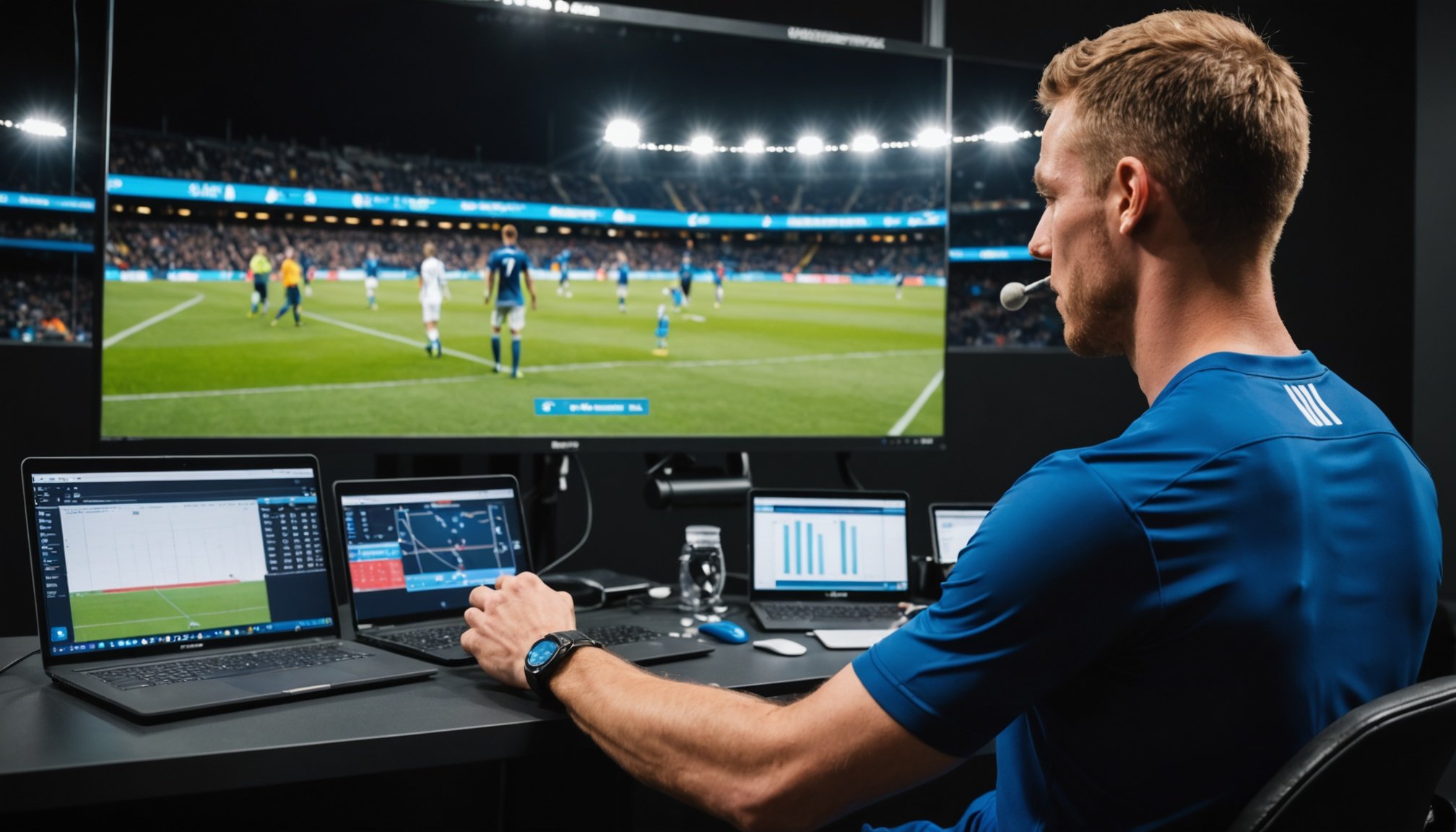Unlocking Peak Performance: How Football Players Leverage Biofeedback for Enhanced Physiological Responses in Matches
The Rise of Biofeedback in Sports
In the highly competitive world of football, athletes and coaches are constantly seeking innovative ways to enhance performance and gain a competitive edge. One of the most promising technologies in this pursuit is biofeedback, a method that allows athletes to monitor and control their physiological responses in real time. This article delves into how football players are using biofeedback to optimize their performance, manage stress, and improve overall athletic prowess.
Understanding Biofeedback and Neurofeedback
Biofeedback and neurofeedback are closely related techniques that involve the use of equipment to provide athletes with real-time data about their physiological states. Biofeedback focuses on various bodily functions such as heart rate, blood pressure, and muscle tension, while neurofeedback specifically targets brain activity.
Topic to read : Reviving the Game: Strategies for UK Football Coaches to Effectively Support Players Returning from Extended Injuries
For football players, biofeedback can be particularly beneficial in managing stress and anxiety, which are common challenges during high-pressure matches. As noted in research, biofeedback and neurofeedback can help athletes develop self-awareness and self-regulation skills, leading to improved performance and reduced stress levels[1][5].
Key Components of Biofeedback Training for Football Players
Precision and Power: The Inner Armor Approach
One of the leading programs in biofeedback training for athletes is Inner Armor, which emphasizes the brain-body connection. This program is designed to build resilience across three main performance pillars: precision, power, and practice.
In parallel : Boosting Football Players” Stamina: The Power of Periodized Training Programs
-
Precision: This involves vision training to improve eye movement accuracy, binocular vision, and reduce eye-brain strain. For football players, enhanced visual processing speeds can be crucial in quickly reading the game and making swift decisions[2].
-
Power: This component focuses on diaphragmatic breathing and heart coherence biofeedback training. By increasing heart-rate variability (HRV), athletes can reduce stress, recover quicker, and enhance their overall resilience. For example, a collegiate athlete mentioned that the breathing program helped them remain calm and focused during high-pressure situations on the court[2].
Breathing Techniques and Heart Rate Variability
Diaphragmatic breathing is a cornerstone of biofeedback training for football players. This technique helps in regulating the autonomic nervous system (ANS), which is often out of balance in athletes under constant stress. Here are some key benefits of diaphragmatic breathing:
- Reduced Stress: By promoting deeper, more controlled breathing, athletes can lower their stress levels and enter a state of relaxation.
- Improved Heart Rate Variability: Increased HRV is associated with better physical and mental resilience, allowing athletes to recover faster and perform at a higher level.
- Enhanced Decision Making: Calm and focused athletes make better decisions on the field, which can be the difference between winning and losing.
### Benefits of Diaphragmatic Breathing in Football
- Reduces stress and anxiety
- Improves heart rate variability (HRV)
- Enhances recovery and resilience
- Improves decision-making under pressure
- Promotes better sleep quality
Real-Time Data and Performance Enhancement
The use of real-time data is a significant aspect of biofeedback training. Wearable technology and advanced sensors allow athletes to monitor their physiological responses during practice and actual games. Here’s how this real-time data can enhance performance:
Data Analytics in Sports Medicine
Advanced data analytics play a crucial role in sports medicine, enabling coaches and trainers to tailor training programs to individual athletes’ needs. By analyzing data on heart rate, muscle tension, and other physiological markers, trainers can identify areas where an athlete might be struggling and implement targeted interventions.
### How Data Analytics Enhance Performance
- Personalized training programs
- Real-time feedback during practice and games
- Identification of potential injury risks
- Optimization of recovery strategies
- Enhanced fan engagement through data visualization
Practical Applications in Football
In football, real-time data can be used in several practical ways:
- Injury Prevention: By monitoring muscle tension and other physiological markers, trainers can identify early signs of potential injuries and take preventive measures.
- Pre-Competitive Preparation: Athletes can use biofeedback to ensure they are in the optimal physiological state before a match, reducing competitive anxiety and improving focus.
- Game-Time Adjustments: Coaches can use real-time data to make strategic decisions during the game, such as when to substitute players or adjust tactics.
Mindfulness and Meditation in Biofeedback Training
Mindfulness and meditation are increasingly being integrated into biofeedback training programs for athletes. These practices help athletes develop a greater awareness of their mental and physical states, leading to improved concentration, flow state, and overall performance.
Mindfulness Training Approaches
Several mindfulness training approaches have been developed specifically for athletes, including:
- Mindfulness-Acceptance-Commitment (MAC): Focuses on mind-body experiences and acceptance of thoughts and emotions without judgment.
- Mindfulness Sports Performance Enhancement (MSPE): Aims to improve concentration, flow state, and confidence while reducing burnout and exercise anxiety[4].
### Benefits of Mindfulness in Football
- Improves concentration and focus
- Enhances flow state and performance
- Reduces burnout and exercise anxiety
- Improves emotional processing and decision making
- Increases resilience to failure
Ethical Considerations and Future Directions
As biofeedback and neurofeedback become more prevalent in sports, there are several ethical considerations to address:
- Privacy and Data Security: Ensuring that athletes’ personal data is protected and used ethically.
- Fair Play: Preventing the misuse of biofeedback technology to gain an unfair advantage.
- Accessibility: Making these technologies accessible to athletes at all levels, not just those in professional leagues.
Looking to the future, the integration of biofeedback with other technologies like virtual reality and wearable technology holds great promise. These advancements could provide even more detailed and personalized feedback, further enhancing athletic performance.
Biofeedback is revolutionizing the way football players prepare for and perform in matches. By leveraging this technology, athletes can gain a deeper understanding of their physiological responses, manage stress and anxiety, and optimize their performance. As the field continues to evolve, it is clear that biofeedback will play an increasingly important role in helping athletes achieve peak performance.
### Key Takeaways for Football Players
- Use biofeedback to monitor and control physiological responses
- Incorporate diaphragmatic breathing to reduce stress and improve HRV
- Utilize real-time data for personalized training and injury prevention
- Integrate mindfulness and meditation into your training routine
- Stay informed about the latest advancements in biofeedback technology
In the words of a current NFL quarterback who uses Inner Armor’s training program, “Vision therapy is the next frontier in athletics. Spatial awareness is key to being a great athlete in any sport, yet few people train for it. I am a better quarterback because I have improved my vision”[2].
As the sports world continues to embrace biofeedback and neurofeedback, it’s clear that these technologies will be instrumental in helping athletes unlock their full potential and achieve peak performance.






